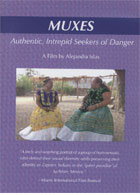
Muxes – Authentic, Intrepid Seekers of Danger 2006
Distributed by Ethnoscope Film & Video, PO Box 92353, Rochester, NY 14692; 585-442-5247
Producer n/a
Directed by Alejandra Islas
DVD, color, 105 min.
Sr. High - Adult
Anthropology, Central American Studies, Gay and Lesbian Studies, Gender Studies, Latin American Studies, Multicultural Studies, Sociology
Date Entered: 02/23/2007
Reviewed by Meghann Matwichuk, Morris Library, University of DelawareIn some communities, young boys who exhibit tendencies toward decidedly feminine traits and behaviors are accepted as members of a third sex. In the Oaxacan city of Juchitan, these transgendered individuals are knows as muxes; in India, they have historically been called eunuchs, or hijra. Two new documentaries give an intimate view of the struggles of these individuals as they assert their right to live and love: Muxes: Authentic, Intrepid Seekers of Danger and Harsh Beauty.
Muxes celebrates the open-mindedness of the inhabitants of Juchitan, explaining how this modest, middle-class town came to be known as Queer Paradise. Close in many respects to its indigenous Zapotec culture, one gets the sense that the gay community's widespread acceptance is rooted in historic mythologies and the area's matriarchal way of life. It is common for muxes to take on creative, traditionally feminine roles: we meet a hairdresser, a seamstress, a cook, and a school teacher. However, the diversity within the muxes' community is immediately apparent. Some dress and act as women, others do not. They have different attitudes toward their place in society. A younger muxe complains of discrimination; an older, worldlier muxe shakes his head incredulously, no doubt recalling an earlier, more difficult time: "Doesn't she realize she's been given the chance to live in peace?" The danger alluded to in the film's title is addressed in a segment about the effect of AIDS on the muxes. Some, having been deeply affected by the HIV crisis, have become advocates who disseminate information about the disease. Other muxes' cavalier attitudes belie a perilous, hard-bitten cynicism and disappointment in the act of sex itself. Indeed, many turn to prostitution; in a culture where a high premium is placed on a bride’s virginity, sex with the muxes is seen as an appropriate outlet for young men's sexual desires.
Harsh Beauty covers much of the same ground but with a darker undercurrent. The filmmaker follows three eunuchs over the course of four years. Although they are able to find acceptance in their communities on the fringe of Indian society, most report histories of physical abuse and shame as well as a difficult struggle to find happiness. Paradoxically, they claim they are a "gift of nature", which allows them to define their roles in society as spiritual. One of the eunuchs, Usha, makes her living as a prostitute while blessing shops during the day for alms. The production also follows the days-long Koovagam Festival, in which the eunuchs celebrate their spiritual connection to Krishna, who transformed himself into a woman so that the legendary soldier Aravan would not die without a wife. The most successful of the film's subjects, Hira Bai, is an elected politician who strives against political injustice. However, her prejudices quickly surface as she describes the difference between hermaphrodites, such as herself, and "false" eunuchs, suggesting that abstinence is the only dignified lifestyle for those like her. HIV and poverty are a very real threat to the eunuch's well-being; indeed, Usha disappears after a serious illness, and is feared dead.
Both films take a verité approach to their subjects, allowing them to tell their own stories without comment by the filmmakers. The audience comes to know the men as cameras informally document their day-to-day lives and interactions with friends, family, and neighbors. The resulting portraits give the viewer an understanding of their hopes and fears. However, neither production situates its subjects in much of an historical context, leaving the audience with a limited understanding of the broader impact of these communities on those outside of their immediate circle. As such, these works might be more useful for those who already have a basic understanding of the cultural anthropology of the regions or topics represented, and would be good additions to collections supporting programs related to anthropology and gender studies.
These productions recall an earlier documentary, Juchitan: Queer Paradise (Macumba International, 2003), which features some of the same transgendered individuals who appear in Muxes. A tighter production in many respects, Juchitan sets the stage by relating a mythological tale explaining the prevalence of transsexuals in that area. It centers the stories of the individuals it follows on a single event -- preparations for a vela, or grand ball, that celebrates the spirited life of the muxes -- lending the 2003 production a greater sense of focus.
American audiences may be surprised by the progressive attitudes displayed by the members of these communities, especially given the traditional machismo of Mexican culture and the rigid caste system prevalent in Indian society. While acknowledging that prejudices do exist to varying degrees, self-identified queers and heterosexuals live relatively harmoniously, recognizing the roles that third-sex people can fulfill with their characteristic boldness and colorful individuality.